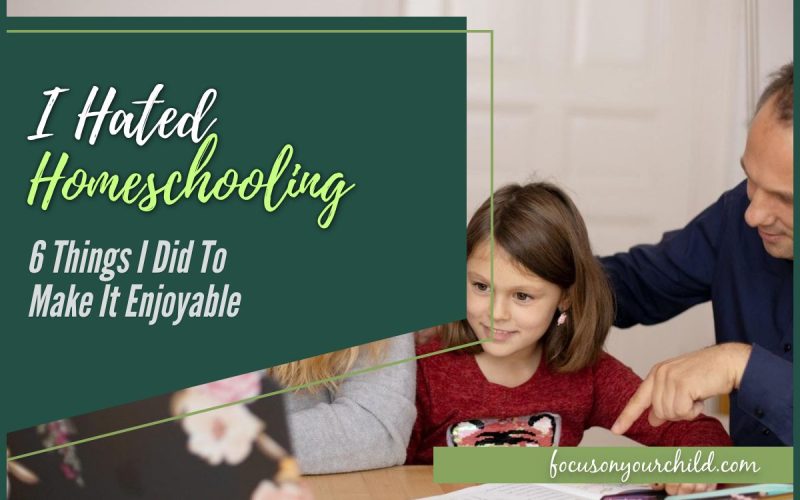It’s fair to hate homeschooling given its many egregious drawbacks: it’s tedious, exhausting, and difficult to keep on track for both parents and children. That’s not even getting into the need to design, organize, and implement study plans tailored to meet your child’s individual needs. Some frustration is to be expected, but there may be a few unexplored options that might make the whole ordeal a bit easier for everyone.
Make sure to establish some order first – designated study areas, regularized schedules, and long-term learning goals are a great start. After the initial structure is set, integrate new learning tools as needed. Things that aren’t allowed in “normal” school like movies and field trips are fair game here, so use whatever works best for your kid. Lastly, try to get in touch with nearby homeschooling groups to learn from their communal experience.
It can be tricky at first, but with some patience and discipline, you’ll probably hate homeschooling a lot less than when you started. Below are a few painless and effective ways to make the most out of your child’s homeschooling experience.
Things You Must do if You Hate Homeschooling
1. Work off a Schedule

Schedules are a crucial component of successful homeschooling. Distractions are commonplace, and can readily get in the way of both teachers and students. Not only does this risk your child putting off more and more responsibilities over time, but it even puts you at risk of enabling the same type of compromises in your schedule!
This is because entertainment isn’t the only type of distraction you need to be mindful of. Other responsibilities like chores and work can become just as much of a hindrance to regulating study plans. The most challenging part is how easy they are to justify. Enabling any sort of distraction is bad, so always plan ahead and clarify that your obligations do not overlap.
Organize a Strict Schedule
Be sure to organize a strict schedule and follow-through meeting it to the best of your ability. Don’t forget that you’re also setting an example to your child here – if they see you make a habit of skipping out on homeschooling (regardless of reasoning) it might influence them to do the same. The longer you let it be, the harder it is to unlearn.
Long-term Learning Goals
This should also apply to long-term learning goals. When designing your child’s educational modules, it’s important to provide goals and timetables along with their lesson plans. Make sure that the deadlines you provide are feasible to meet.
Break down into Chunks
We’d recommend breaking down longer learning objectives into more modest increments. This allows your child to feel their own progress while providing you with a metric to gauge the efficacy of both your modules and teaching method.
Inclusion in the Drafting Process
We strongly urge you to include your child in the drafting process of their study plan. These schedules work best when everyone is fully aware of the terms they’re working with. Aim to reach a fair, productive compromise that keeps them learning at a steady pace without needlessly exhausting them. Done right, you might even bond with them over all of this!
2. Set Up a Designated Study Spot
One of the biggest perks of homeschooling is the unparalleled flexibility it offers. If not utilized properly though, this can easily lead to a very messy learning experience. Overlapping home life and work activities can adversely affect productivity due to the abundance of available distractions. It’s important to separate work and home life, or you risk having both suffer from the overlap.
A designated learning space adds a layer of crucial separation between home and homeschool, reducing the likelihood of distractions and reinforcing a more focused mindset. It’s an effective strategy that only requires a modest amount of preparation.
A room with a window is preferable for improved productivity – especially if it provides a channel for natural light. That said, any closed room can suffice. Their area of choice must be free of as many distractions as possible: toys, technology, and even food need to be cleared off before your child gets to learning.
Be sure to place all of their study materials in one consistent spot. We’d recommend helping them pack it away for the first few weeks to help them pick up the habit.
3. Find Some New Learning Tools
Homeschooling lets you take a lot of liberties the normal academic system wouldn’t permit. Be sure to take advantage of these to improve your child’s learning experience.

Try to include some art projects into their study plan. There are plenty of available mediums for art, and you can apply them as needed depending on your child’s developmental age. Coloring books and crayons are a good start when they’re younger, and you can gradually include complex tasks that require more attentiveness and coordination. Paint-by-numbers kits are a solid example of that and can prove not only educational but cathartic for older students.
Educational games are another great choice to add to their curriculum. Different genres emphasize different skills for them to hone with practice. For example, a typing game that tracks words per minute can grant them a better understanding of how to improve their capabilities on a keyboard – a crucial soft skill to pick up in this day and age!
When it comes to the subject modules themselves, not everything needs to be made from scratch. There is an abundance of resources for you to access, all catering to different educational niches. These provide information in a cohesive, flowing manner that reduces how much work you need to sink into organizing the lesson plan. Some topics can even be covered through premade educational playlists alone!
4. Find Opportunities to Break the Monotony
One of the biggest reasons people hate homeschooling is because of how repetitive it can get. A few fresh faces, or even a quick change of scenery, can do wonders at improving your child’s mood.
Socializing

Socialization is a valuable factor in your kid’s development. While parents take the main educator role, children still stand to benefit more from multiple sources of social interaction. Family members or even other kids can provide them with new contexts, dynamics, and environments to apply themselves to.
For younger kids, try to schedule a playdate for them. You even get a much-needed break out of this. Children their age make for great playdate company due to similar developmental ages, but there’s nothing wrong with inviting family or friends to spend time with your kid.
When your child’s a bit older, we’d recommend letting them exercise control over these events. Offer to let them have hangouts with their friends so long as they mind their messes. This lets them exercise their personal agency in a responsible way, on top of providing a much-needed change of pace in their life.
Scenery Changes
If it’s just not feasible to meet with people, something as small as a new view can make all the difference. Don’t worry about extreme preparation for these cases: bringing your kids as a ride-along while you shop is already a great start. A family trip out into the woods could also appeal to some, and allows your family to catch up in an environment free of responsibilities.
5. Get In Touch with Other Homeschoolers
Just because you’re doing this without the school doesn’t mean you’re the only one handling this kind of situation. Plenty of parents homeschool their children – groups like these are quite common nowadays given the surge in remote learning during the pandemic.
These communities will have more experience than you do, and the vast majority of their members would be more than willing to share any information that could make homeschooling more pleasant for you and your child.
A good start to finding these people is checking out Facebook groups or websites. You could contact other parents or perhaps even check out forums and discussion boards. Other homeschooling families shouldn’t be too hard to find, and what they have to offer will be well worth the effort.
6. Give Yourself (And Your Child) A Break

Please remember that even big schools struggle with helping all of their students. There are many reasons why that might be the case, but what’s most important here is how this problem gets resolved. If your child gets stuck learning, don’t push them to brute force the process. You’re a parent first, teacher second. Feel free to cut them some slack from time to time.
Sometimes they may not progress as fast as you’d like them to. If that’s the case, check your schedule first. The learning plan you drafted just might not be feasible. You can always get a second opinion by checking existing study plans or straight-up asking other homeschoolers for their thoughts. Even if it’s technically feasible, it just might not be right for your child.
Homeschooling varies depending on a lot of factors that aren’t in your control. Trying to force the outcome you want will only lead to one or both of you growing resentful. Always strive to be patient with your kid when educating them.
A nice compromise between learning and recreation is watching educational videos together. Nature documentaries, science gameshows, and other similar content can easily be viewed with family. This even lets them ask you questions about concepts as they come up, allowing you to identify where they struggle to follow. It also doubles as a great bonding opportunity!
Who knows? You might even learn something new while watching with them!
Final Thoughts
If you hate homeschooling, don’t worry, you’re not the only one, remember that it can be challenging, but not impossible. It’s important to prioritize structure, but don’t let yourself get bogged down following what “normal” schools do. Use all the tools available, and integrate what works best for your child.
Always prioritize your child’s wellbeing, and these guidelines should provide more than enough information to help you comfortably meet their educational needs.
